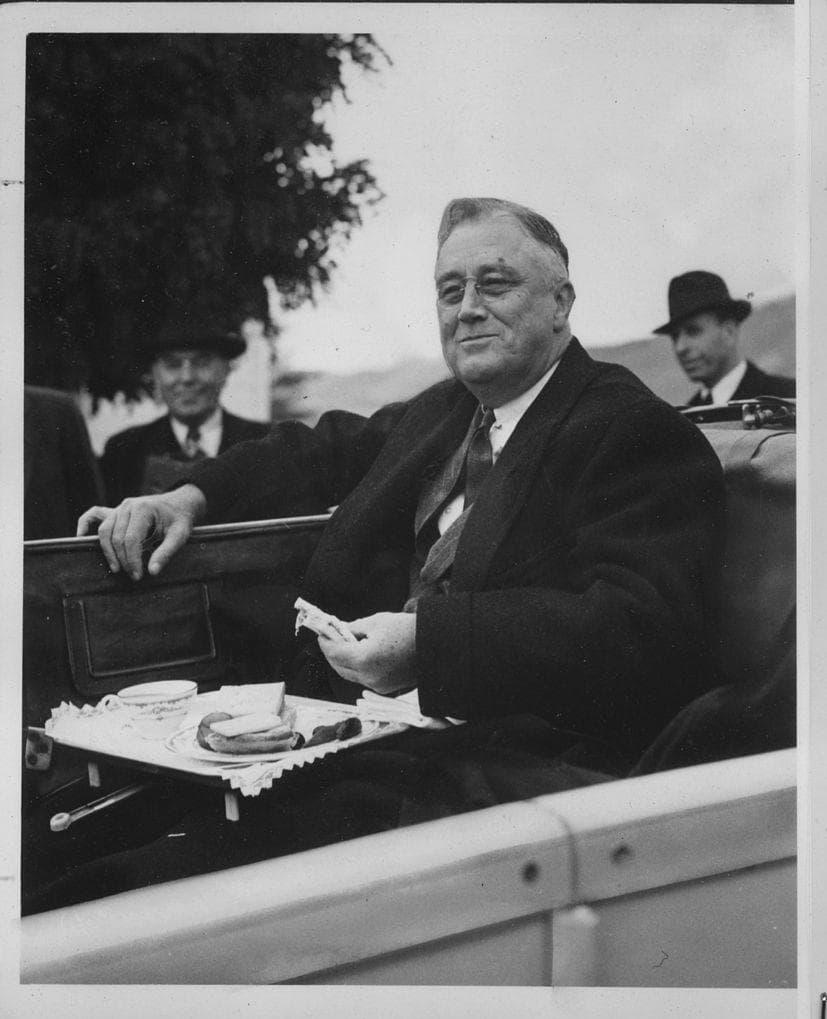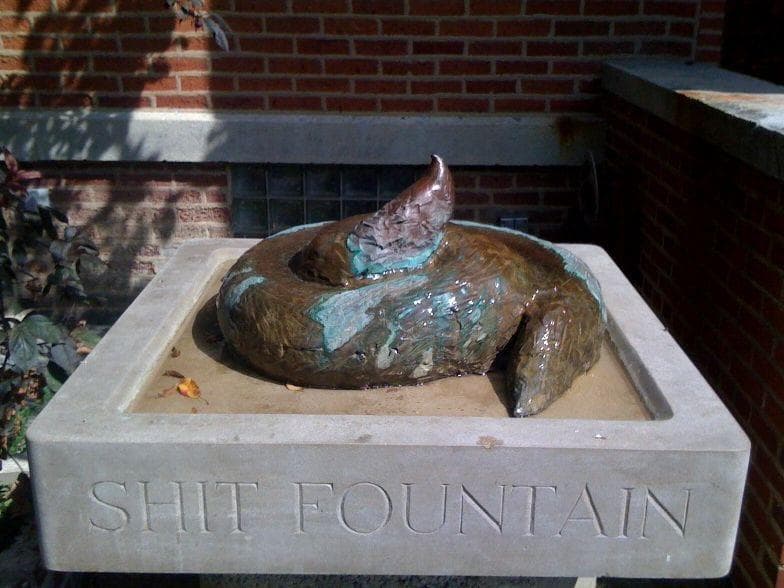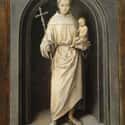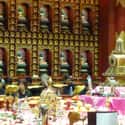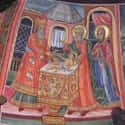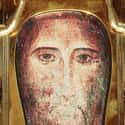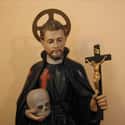-
(#1) If Saint Gennaro's Blood Doesn't Liquefy, It's A Bad Omen
Saint Januarius, known as Saint Gennaro in Italy, lived during the 3rd and 4th century CE. As a Christian bishop, Gennaro suffered persecution ordered by the Roman emperor Diocletian. According to legend, Roman guards tortured Gennaro and threw him into a furnace. He managed to escape unharmed, so the Romans beheaded him instead.
A slave named Eusebia kept a vial of his blood at the time of his death until the church named Gennaro a martyr decades later. Wanting to add the vial to his other sacred remains, Eusebia brought the dried blood to the procession of Gennaro's remains on its way to the Naples catacombs. While observing the event, she discovered the blood had returned to liquid form.
Ever since scholars started recording this phenomenon in 1389, archbishops have included the blood in semi-annual celebrations of Gennaro. If the blood goes from a solid to liquid state, then everything's fine. If the blood remains solid, though, people consider it a bad omen.
In the 20th century, Gennaro's blood stayed solid in 1939, when World War II began, and in 1980, when a large earthquake hit southern Italy. Gennaro's blood also remained solid in 2017, but the unfortunate event it heralded remains up for debate.
-
(#2) An Image Of Our Lady Of Guadalupe Hasn't Aged In Nearly 500 Years
In 1531, a Mexican farmer named Juan Diego heard someone singing, only to encounter a vision of the Virgin Mary. She instructed Diego to ask the bishop to build a church, so she could help the people of Mexico.
Diego did what she asked, but the bishop didn't believe his story. Mary asked Diego to try again, and the bishop asked for proof. In a third vision, Mary told Diego to pick flowers and bring them to the bishop. As Diego unveiled the flowers from his cloak to the bishop, a picture of Our Lady of Guadalupe appeared on the fabric, convincing the bishop. That blessed cloak remains on display.
Although the image appears on a fabric woven from cactus fibers nearly 500 years ago, it has not faded, nor has the material deteriorated. Scientists have examined the image extensively and can offer no explanation. Some believe it's impossible a human painted the image, since it doesn't use any mineral or animal coloring - necessary ingredients for paint and ink at the time. The image of Our Lady even survived a bomb blast at the Basilica of Guadalupe in 1921, despite being a few feet from the explosive device.
-
(#3) The Head Of Saint Catherine Turned Into Roses
Born in 1347, Saint Catherine became a nun at a young age. She experienced visions of Jesus throughout her life, including one where he gave her a wedding ring made from his foreskin. A priest claimed he once saw Catherine levitating, and stories describe her receiving a stigmata at age 28. When she died in Rome five years later, she received a burial in the city - but citizens in her hometown of Siena wanted her buried there.
Since sneaking an entire body past Roman guards would be difficult, they removed her head and placed it in a sack. According to stories, Roman guards stopped the group of Siena citizens, but when they looked in the bag, Catherine's head transformed into rose petals. The guards allowed the group to pass and return to Siena where Catherine's head miraculously regained its original shape.
The head is currently displayed in the Basilica of San Domenico. And although her body remains in Rome, her ribs, a foot, and other body parts are showcased elsewhere in the world.
-
(#4) Women With Fertility Trouble Visit A Grotto Blessed By The Virgin Mary's Breast Milk
According to legend, Mary and Joseph stopped in a cave near Bethlehem to feed Jesus while running from King Herod's men. As Mary nursed the baby, a drop of breast milk landed on the ground and turned the entire cave white. Chapels and churches were built around the Milk Grotto beginning in the 4th century. And people have scraped pieces off the walls, sending them to churches all over the world to display as relics.
The Milk Grotto became a destination for women seeking fertility help. They pray to "Our Lady of the Milk" and scrape dust from the limestone walls, which they add to a drink and consume. Photos of children born thanks to the power of the Milk Grotto line the walls, and claims exist of more than 3,000 children born due to mothers' visits. Even those not looking to have children consume the cave dust to feel closer to the Virgin Mary.
-
(#5) After Death, All But Saint Anthony's Tongue Turned To Dust
Saint Anthony of Padua, Italy was renowned for his excellent speaking ability. The priest traveled around Italy and France, delivering sermons buoyed by his strong voice, memory, and ability to simplify complex subjects. Even after his death in 1231, people claimed Anthony appeared in their dreams, urging them to attend confession. The next year, Pope Gregory IX canonized Anthony.
In 1263, the church exhumed Saint Anthony's remains to send to a cathedral. Although his body decomposed naturally, his tongue somehow remained intact and even appeared healthy. The church created special decorative containers for Anthony's tongue and jaw bone, complete with glass for easy viewing at the Basilica of Saint Anthony of Padua.
-
(#6) Saint Spyridon's Shoes Show Evidence Of Regular Use
Saint Spyridon lived in Cyprus from about 270 to 348 CE, working as a shepherd before becoming a bishop. According to legend, he explained the Holy Trinity to the Council of Nicaea in 325 by comparing the Trinity to a brick. As he spoke, water was said to miraculously drip out of the brick, with fire rising from the stone. Although Spyridon reportedly completed other miracles during his lifetime, his icon often depicts a flaming brick in one hand.
Three centuries after Spyridon died, his body was exhumed and moved to safety from invading Saracen troops. The exhumers discovered Spyridon's flesh remained well preserved, considering how long it had been buried, and it smelled like fresh basil. The relics received a home in a Corfu church and come out for viewings on his feast day.
People claim his shoes often look worn down as if he's been out walking, inspiring the priests to add a removable bottom to his coffin for easier access when changing the saint's footwear.
-
(#7) Buddha's Teeth Grant Great Power And Continue To Grow
When the Buddha passed away sometime during the 6th or 4th century BCE, monks discovered relics among his cremated ashes. According to legend, several of these relics included teeth, and one became the possession of King Brahmadatte. The tooth gained recognition as a symbol of power, and many countries invaded Sri Lanka to take the tooth for themselves - starting wars and forcing the tooth's guardians to move it to different temples.
Buddhists believe the tooth from the legends is housed in the Temple of Sacred Tooth in the Sri Lankan city of Kandy. The tooth rests inside several caskets made of gold, and the temple hosts a 10-day festival each year in honor of the tooth, complete with elephants and fire-breathers.
Other temples claim to have tooth relics from the Buddha, as well. A 2-inch-long molar located at a Buddhist temple in Los Angeles allegedly continues to grow, and visitors believe the tooth helps heal their pain. They also say the tooth's odor changes in response to prayers and sometimes emits light.
-
(#8) The Holy Prepuce Allegedly Possessed Healing Power And Embarrassed The Vatican
Religious scholars claim when Jesus ascended to heaven, he left his foreskin behind. When the Holy Prepuce was allegedly discovered in 1557, strange phenomena followed. Mists of perfume randomly appeared in the village where it was discovered, and freak storms brought damage. Worshippers claimed the foreskin possessed healing powers, as well, and it allegedly cured blind people after they rubbed it on their eyelids.
In 1900, another relic believed to be Jesus's foreskin turned up in France. Perhaps fearing a conflict over which of the two foreskins was more legitimate, or embarrassment over debating such an intimate relic of Christian faith, the Vatican forbade any mention of the Holy Prepuce and threatened excommunication to anyone who wrote or spoke about it. The Holy Prepuce attracted interest until the relic housed in Calcata mysteriously went missing in 1983.
-
(#9) Saint Stephen's Right Hand Didn't Decompose With The Rest Of His Body
The first monarch of Hungary, King Stephen I, became a saint after he died in 1038. When people exhumed Saint Stephen's body years later to move it to a safer spot, they realized his right arm did not decompose like the rest of his body. People saw this as a miracle and removed the arm for preservation.
Saint Stephen's arm became known as "The Holy Right," and at one point, a group of Croatian monks cut the hand off from the rest of the arm while they were guarding it, further splitting up the relic. The clenched hand now resides at the Basilica of St. Stephen in Hungary, enclosed in a case and draped with jewels. Some question the authenticity of the relic, since the original wore a ring and the displayed hand lacks a mark indicating a ring was ever there.
-
(#10) Saint Naum's Heart Beat After Death - And His Miracles Continued
According to legends, Saint Naum of Macedonia completed many miracles during his lifetime, most of a healing nature. He allegedly cured mental illness, healed the disabled, and gave voice to the mute.
Although he died in 910 CE, Naum's miracles continued. He reportedly appeared in the dreams of thieves, urging them to return what they stole. One story claims a boat found it impossible to move until a passenger who took silver from the Monastery of Saint Naum returned the item. Naum lies buried in his namesake monastery, where some say, if you place your ear to his sarcophagus, you can still hear his heart beating.
-
(#11) The Mandylion Of Edessa Allegedly Cured A King Of Leprosy
According to legend, King Agbar of Edessa contracted leprosy around the time of Jesus's ministry. After hearing Jesus possessed miraculous healing powers, King Agbar sent him a letter requesting he come to Edessa and cure him. Jesus replied he was unable to travel there, but would send one of his disciples instead.
Stories claim Agbar then sent a painter to capture an image of Jesus, and the artist became temporarily blinded by his radiance. Although he was unable to create a painting, Jesus wiped his face on a towel, and an image of his face miraculously appeared on it. When the painter returned with the towel and gave it to the king, the monarch's leprosy vanished. The towel became known as the Mandylion of Edessa and made its way to the Vatican, where it is rarely shown to the public.
-
(#12) The Body Of Saint Mark Saved A Ship From A Storm
Saint Mark the Evangelist, follower of Jesus and New Testament contributor, founded an orthodox church in Egypt before his death in 68 CE. The people of Alexandria buried Mark's body in Egypt, but when Christians in Venice discovered an Alexandrian khalif had plans to destroy Mark's relics more than 800 years later, they decided to steal the body. A pair of Venetian merchants traveled to Alexandria and persuaded two monks guarding the body to swap it with another.
The merchants hid Mark's stolen body on board their ship and, according to legend, the ship experienced several miracles attributed to Mark during their journey to Venice. The saint's body reportedly helped the boat narrowly escaped destruction in a storm, exorcised a possessed man in Istria, and made the trip home abnormally quick. When they arrived in Venice, Mark's body suddenly became too heavy to move, forcing followers to build San Marco's Basilica around him.
-
(#13) Francisco Franco Kept Saint Teresa's Mummified Hand For Years
Saint Teresa of Avila lived from 1515 to 1582 and began her time as a nun after her family sent her to a convent. Although romance interested her at first, she experienced visions of an angel stabbing her in the heart with a hot spear. She claimed it was painful yet exciting, and it made her fall in love with God.
As her life as a nun continued, she allegedly levitated during holy visions so often that she weighed herself down with a saddle and stones. Teresa traveled around the countryside, establishing a friary and 17 convents.
After she died, nuns claimed to smell something pleasant coming from her burial site. When people opened her grave years later, they found her corpse in amazing condition - and it smelled of lilies. Various parts of Teresa became relics, including one of her hands, which the dictator Francisco Franco obtained, kept by his side, and slept near until he died in 1975.
-
(#14) Saint Camillus's Preserved Heart Inspires Caring In Others
As a young man, Saint Camillus reportedly suffered from a gambling problem and worked as a soldier of fortune - not typically the lifestyle choices of a saint. He also possessed healing power, however, and devoted his later life to helping others.
Camillus became a hospital worker and inspired others to care for the sick and injured through his compassionate example. The caregivers who followed in his footsteps founded The Ministers of the Sick or the Infirm, also known as the Camillians, and wear white robes with a large red cross decorating their chest.
When Camillus died, his followers removed his heart as a relic. They noted it was still a healthy shade of red and beautiful looking. They enclosed it in a glass display and kept the heart in a former infirmary room, which later became a chapel. The Camillians occasionally send the heart on tours through their churches in other countries, inspiring their followers to care for others.
New Random Displays Display All By Ranking
About This Tool
Faith is the return of the soul, the reverence and worship of life. For this reason, our ancestors expressed their reverence for life with a kind of respect for God. Religious beliefs provide guidance when human knowledge and abilities are limited, and many people are also used to explaining strange and unexplainable phenomena surrounding religious relics in the name of gods.
There are many mysterious ancient religious relics all over the world, and they frequently appear in many novels or historical records. These fascinating religious relics are of great significance to devout believers. The random tool described 14 weird phenomena surrounding religious relics that can not be explained till today.
Our data comes from Ranker, If you want to participate in the ranking of items displayed on this page, please click here.



